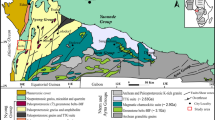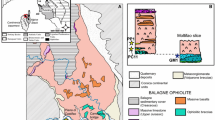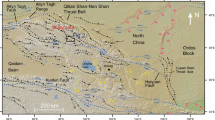Abstract
Inherited deformation microfabrics of detrital quartz grains and U–Pb (Laser ablation (LA)-ICPMS and ID TIMS) ages of detrital zircons separated from the Phyllite–Quartzite Unit s.l. of the Talea Ori, central Crete, suggest strikingly different source rocks. Albite gneiss of the lower Rogdia Beds includes Cambrian and Neoproterozoic rounded zircons with main U–Pb age peaks at 628 and 988 Ma. These and minor Paleoproterozoic and Archean peaks, together with the lack of Variscan-aged and Mesoproterozoic zircons, are similar to the age spectra obtained from the Phyllite–Quartzite Unit s.str. of the Peloponnesus and eastern Crete and from the Taurides. All of these zircons should be derived from the northeastern passive margin of Gondwana (Cimmeria). Metatuffites of the uppermost Rogdia Beds and metasandstone of Bali beach, on the other hand, include euhedral detrital zircons displaying a Variscan U–Pb age spectra at ca. 300 Ma with concordia ages at 291 ± 3, 300 ± 1 Ma (Rogdia) and 286 ± 3, 300 ± 3, 313 ± 2 Ma (Bali). Both types of metasediments and their zircons are similar to those of the pre-Alpine basement and overlying Tyros Beds of eastern Crete, revealing a provenance at the southern active margin of Laurasia. Thus, in central Crete the Paleotethys suture should be situated inside the Rogdia Beds. Magmatic zircons separated from a rhyolite boulder of the lower Achlada Beds yielded a concordant U–Pb zircon age at 242 ± 2 Ma placing a maximum age for the deposition of the (meta)conglomerate from which the boulder was collected. This age is compatible with an Olenekian-early Anisian age of the underlying Vasilikon marble suggested by new findings of the foraminifera Meandrospira aff. pusilla. Both the Achlada Beds and the Vasilikon marble can be attributed to the lower Tyros Beds of eastern Crete. The Alpine deformation led to a pervasive mylonitic foliation, which is affecting most of the studied rocks. This foliation results from D2 top-to-the-north shearing, which post-dates the growth of blue amphiboles (crossite).


















Similar content being viewed by others
References
Abbo A, Avigad D, Gerdes A, Güngör T (2015) Cadomian basement and Paleozoic to Triassic siliciclastics of the Taurides (Karacahisar dome, south-central Turkey): paleogeographic constraints from U–Pb–Hf in zircons. Lithos 227:122–139
Bonneau M (1973) Sur les affinités ioniennes des „calcaires en plaquettes“ épimétamorphiques de la Crète, le charriage de la série de Gavrovo-Tripolitza et la structure de l'arc egéen. Compte Rendus de l'Academie des Sciences Paris 277:2453–2456
Burkhard M (1993) Calcite twins, their geometry, appearance and significance as stress–strain markers and indicators of tectonic regime: a review. J Struct Geol 15:351–368
Cayeux L (1902) Sur la composition et l'age des terrains métamorphiques de la Crète. Compte Rendus de l'Academie des Sciences Paris 134:1116–1119
Chatzaras V, Xypolias P, Doutsos T (2006) Exhumation of high-pressure rocks under continuous compression: a working hypothesis for the southern Hellenides (central Crete, Greece). Geol Mag 143:859–876. doi:10.1017/S0016756806002585
Dercourt J, Ricou LE, Vrielynck B (eds) (1993) Atlas Tethys palaeoenvironmental maps. Gauthier-Villars, Paris
Dörr W, Zulauf G, Gerdes A, Lahayec Yann, Kowalczyk Gotthardt (2015) A hidden Tonian basement in the eastern Mediterranean: age constraints from U–Pb data of magmatic and detrital zircons of the External Hellenides (Crete and Peloponnesus). Precambrian Res 258:83–108
Epting M, Kudrass HR, Leppig U, Schäfer A (1972) Geologie der Talea Ori/Kreta. Neues Jahrb Geol Paläontol Abh 141:259–285
Franz L (1992) Die polymetamorphe Entwicklung des Altkristallins auf Kreta und im Dodekanes (Griechenland), Ferdinand Enke
Fytrolakis N (1967) Über einen Fossilfund im Metamorphikum von Ostkreta. Bull Geol Soc Greece 7:89–92
Fytrolakis N (1972) Die Einwirkung gewisser orogener Bewegungen und die Gipsbildung in Ostkreta (Prov. Sitia). Bull Geol Soc Greece 9(1):81–100
Hall R, Audley-Charles MG (1983) The structure and regional significance of the Talea Ori, Crete. J Struct Geol 5:167–179
Haude G (1989) Geologie der Phyllit-Einheit im Gebiet um Palekastro (Nordost-Kreta, Griechenland). PhD thesis, Technical University Munich, Germany
Ho Y (1959) Triassic foraminifera from the Chialingkiang Limestone of South Szechuan. Acta Paleontol Sin 7(5):387–418 (in Chinese with English abstract)
Jackson SE, Pearson NJ, Griffin WL, Belousova EA (2004) The application of laser ablation-inductively coupled plasma-mass spectrometry to in situ U–Pb zircon geochronology. Chem Geol 211:47–69
Katsiavrias N et al (2008) Geological map of Anoyia, Crete, 1:50000, 1st edn. Geological Survey of Greece, Athens
Kock S, Martini R, Reischmann T, Stampfli GM (2007) Detrital zircon and micropalaeontological ages as new constraints for the lowermost tectonic unit (Talea Ori unit) of Crete, Greece. Palaeogeogr Palaeoclimatol Palaeoecol 24:307–321
König H (1982) Unterpermische Seeigel aus Kreta (Griechenland). N Jahrb Geol Paläontol Mo 3:167–175
König H, Kuss SE (1980) Neue Daten zur Biostratigraphie des permotriadischen Autochthons der Insel Kreta (Griechenland). N Jahrb Geol Paläontol Monatsh 1980:525–540
Kozur H, Krahl J (1987) Erster Nachweis von Radiolarien im tethyalen Perm Europas. Neues Jahrbuch für Geologie und Paläontologie Monatshefte, Abhandlungen 174:357–372
Krahl J, Kaufmann G, Kozur H, Richter D, Förster O, Heinritzi F (1983) Neue Daten zur Biostratigraphie und zur tektonischen Lagerung der Phyllit-Gruppe und der Trypali-Gruppe auf der Insel Kreta (Griechenland). Geol Rundsch 72:1147–1166
Krahl J, Kauffmann G, Richter D, Kozur H, Möller I, Förster O, Heinritzi F, Dornsiepen U (1986) Neue Fossilfunde in der Phyllit-Gruppe Ostkretas (Griechenland). Z Dt Geol Ges 137:523–536
Krahl J, Richter D, Förster O, Kozur H, Hall R (1988) Zur Stellung der Talea Ori im Bau des kretischen Deckenstapels (Griechenland). Z Dtsch Geol Ges 139:191–227
Ludwig KR (2001) Isoplot/Ex—a geochronological toolkit for Microsoft Excel. Berkley Geochronology Center Special Publication 1a
Nasdala L, Hofmeister W, Norberg N, Mattinson JM, Corfu F, Dörr W et al (2008) Zircon M257—a homogeneous natural reference material for the ion microprobe U–Pb analysis of zircon. Geostand Geoanal Res 32:247–265
Passchier CW, Trouw RAJ (2005) Microtectonics. Springer, Berlin
Richter D, Kopp KO (1983) Zur Tektonik der untersten geologischen Stockwerke auf Kreta. N Jb Geol Paläont Monatsh 1983:27–46
Robertson AHF (2006) Sedimentary evidence from the south Mediterranean region (Sicily, Crete, Peloponnese, Evia) used to test alternative models for the regional tectonic setting of Tethys during Late Palaeozoic-Early Mesozoic time. In: Robertson AHF, Mountrakis D (eds) Tectonic development of the Eastern Mediterranean region, vol 260. Geological Society of London, Special Publications, pp 91–154
Robertson AHF (2008) Late Palaeozoic–Early Mesozoic metasedimentary and metavolcanic rocks of the Phyllite–Quartzite Unit, eastern Crete (Greece): an extensional, rift-related setting for the southern margin of Tethys in the Eastern Mediterranean region. Z Dtsch Ges Geowiss 159:351–374
Robertson AHF (2012) Late Palaeozoic–Cenozoic tectonic development of Greece and Albania in the context of alternative reconstructions of Tethys in the Eastern Mediterranean region. Int Geol Rev 54:373–454
Romano SS, Dörr W, Zulauf G (2004) Cambrian granitoids in pre-Alpine basement of Crete (Greece): evidence from U-Pb dating of zircon. Int J Earth Sci 93:844–859
Romano SS, Brix MR, Dörr W, Fiala J, Krenn E, Zulauf G (2006) The Carboniferous to Jurassic evolution of the pre-Alpine basement of Crete: constraints from radiometric dating of orthogneiss, fission-track dating of zircon and structural/petrological data. In: Robertson AHF, Mountrakis D (eds) Tectonic development of the Eastern Mediterranean region, vol 260. Geological Society London, Special Publications, pp 69–90
Sannemann W, Seidel E (1976) Die Triasschichten von Rawdoucha/NW-Kreta. Ihre Stellung im kretischen Deckenbau. Neues Jahrbuch für Geologie und Paläontologie Monatshefte 1976:221–228
Seidel E (1978) Zur Petrologie der Phyllit-Quarzit-Serie Kretas. Habilitationsschrift, Universität Braunschweig, p 1–145
Seidel E, Kreuzer H, Wilhelm H (1982) A late Oligocene/early Micocene high pressure belt in the external Hellenides. Geol Jahrb E32:165–206
Stacey JS, Kramers JD (1975) Approximation of terrestrial lead isotope evolution by a two-stage model. Earth Planet Sci Lett 26:207–221
Stampfli GM, Hochard C, Vérard C, Wilhelm C, von Raumer J (2013) The formation of Pangea. Tectonophysics 593:1–19
Theye T, Seidel E (1991) Petrology of low-grade high-pressure metapelites from the External Hellenides (Crete, Peloponnese). A case study with attention to sodic minerals. Eur J Mineral 3:343–366
Ustaömer T, Ustaömer PA, Robertson AHF, Gerdes G (2016) Implications of U–Pb and Lu–Hf isotopic analysis of detrital zircons for the depositional age, provenance and tectonic setting of the Permian–Triassic Palaeotethyan Karakaya Complex, NW Turkey. Int J Earth Sci 105:7–38. doi:10.1007/s00531-015-1225-8
Xypolias P, Doutsos T (2000) Kinematics of rock flow in a crustal-scale shear zone: implication for the orogenic evolution of the southwestern Hellenides. Geol Mag 137:81–96
Xypolias P, Chatzaras V, Koukouvelas I (2007) Strain gradients in zones of ductile thrusting: insights from the External Hellenides. J Struct Geol 29:1522–1537
Zulauf G, Kowalczyk G, Krahl J, Petschick R, Schwanz S (2002) The tectonometamorphic evolution of high-pressure low-temperature metamorphic rocks of eastern Crete, Greece: constraints from microfabrics, strain, illite crystallinity and paleostress. J Struct Geol 24:1805–1828
Zulauf G, Blau J, Dörr W, Klein T, Krahl J, Kustatscher E, Petschick R, van de Schootbrugge B (2013) New U–Pb zircon and biostratigraphic data of the Tyros Unit, eastern Crete: constraints on Triassic palaeogeography and depositional environment of the eastern Mediterranean. Z Dtsch Ges Geowiss 164:337–352
Zulauf G, Dörr W, Fisher-Spurlock SC, Gerdes A, Chatzaras V, Xypolias P (2014) Closure of the Paleotethys in the External Hellenides: constraints from U–Pb ages of magmatic and detrital zircons (Crete). Gondwana Res. doi:10.1016/j.gr.2014.06.011
Acknowledgments
We are grateful to Janina Schastok and Linda Marko (Universität Frankfurt) for her help with the isotopic analyses and to Rainer Petschick (Universität Frankfurt) for carrying out XRD analyses. Reviews by G. Meinhold, A. Okay, and A.H.F. Robertson are acknowledged.
Author information
Authors and Affiliations
Corresponding author
Electronic supplementary material
Below is the link to the electronic supplementary material.
Rights and permissions
About this article
Cite this article
Zulauf, G., Dörr, W., Krahl, J. et al. U–Pb zircon and biostratigraphic data of high-pressure/low-temperature metamorphic rocks of the Talea Ori: tracking the Paleotethys suture in central Crete, Greece. Int J Earth Sci (Geol Rundsch) 105, 1901–1922 (2016). https://doi.org/10.1007/s00531-016-1307-2
Received:
Accepted:
Published:
Issue Date:
DOI: https://doi.org/10.1007/s00531-016-1307-2




